Razer Blade 14-Inch Gaming Notebook Review
by Dustin Sklavos on July 2, 2013 1:00 PM ESTSystem and Futuremark Performance
Despite being remarkably slim, the Razer Blade 14-inch is afforded remarkable capacity for performance thanks to its well-designed cooling system. The result is that despite fitting squarely in Intel's ultrabook category, there's a tremendous amount of horsepower on tap. Razer benefits from advances in Intel's Haswell design by employing the 37W Core i7-4702HQ, a quad-core processor which moves the chipset on package. Meanwhile, they can leverage the increased parallelism of an NVIDIA GK106 (as opposed to GK107 in the last generation of Blades) without substantially higher thermals.
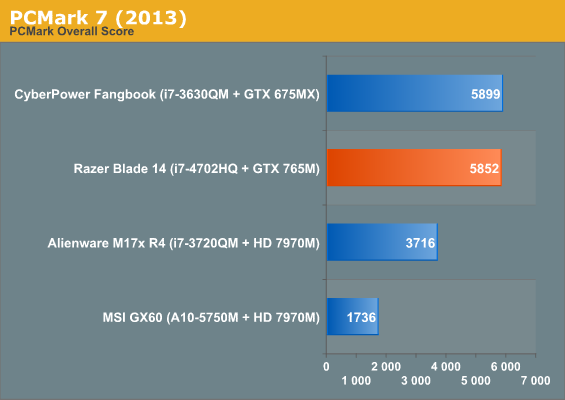
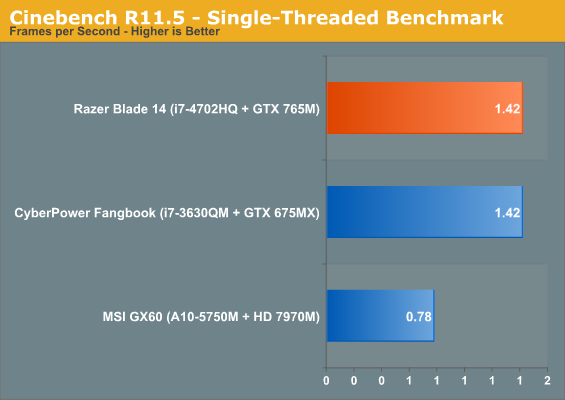

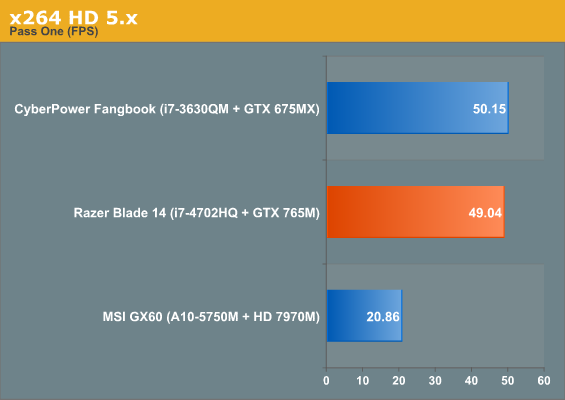

Just how fast is the Blade 14? Fast enough. The i7-4702HQ is able to meet the last generation i7-3630QM's performance without much issue, and ensures that CPU bottlenecks won't be much of an issue during gaming sessions.
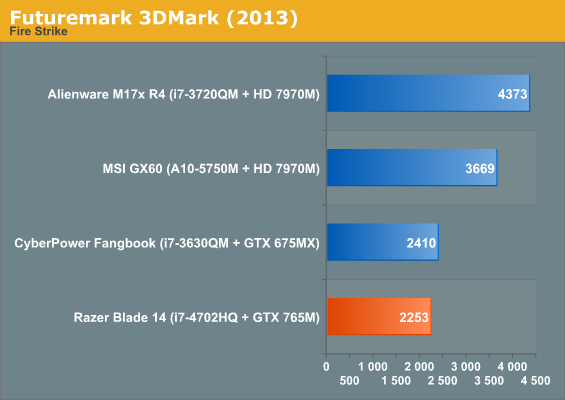

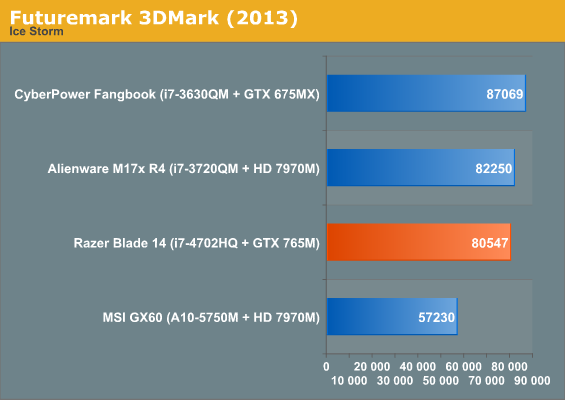
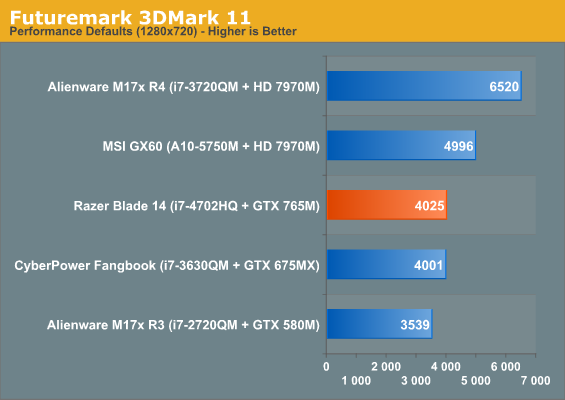
The Razer Blade 14-inch isn't knocking it out of the park in 3DMark, but it doesn't need to. What's impressive is how close it is to the GeForce GTX 675MX; that chip is a full GK106 with 960 CUDA cores and a 256-bit wide memory bus, but the substantially higher clocks on the GTX 765M help make up the difference. What you're going to see as we move forward is that the 765M is actually hampered only by its 128-bit memory bus; shader power is largely present for this chip, and the 1600x900 panel resolution in the Blade 14-inch may actually be the sweet spot for performance.










108 Comments
View All Comments
n13L5 - Friday, July 5, 2013 - link
People already complained about their display panel at Computex, so I had filed a pre-sales ticket with Razer, regarding the display just before they started taking orders. This was their answer:I have read through your email and unfortunately we are unable to share this information, as we may make changes in manufacturing that will change the type and model of LCD panel in use. We can only point you to the product specifications page, which I'm sure you have visited. Once reviews start coming online from the various tech sites they may share more about their impressions of the panel.
Unsurprisingly, the bad commentary on a bad panel isn't showing any signs of changing. Facts are facts (except for the marketing departments of the world)
Hrel - Sunday, July 7, 2013 - link
Idk, I still feel like this style of gaming laptop won't be a... comfortable proposition until we get another manufacturing shrink. Which just depresses me since it means AMD is right out. Intel's pricing has been getting absurd over the years. I really like what Razer is doing here though, I don't think it's bad now, but I still wouldn't call this platform "mature".Hrel - Sunday, July 7, 2013 - link
Also, not having 802.11ac at this point, ESPECIALLY at this price point, is simply unnaceptable.I agree completely with your laments on the LCD. I'd still pick Alienware if I were to spend this kind of money. Especially since how thing/light it is has no bearing on my decision at all. I'm a man though, not a girl. So I can't even tell the difference between 5 and 15lbs, much less 4 and 6. As long as it's under 50lbs in the bag with everything I'm good.
geniekid - Monday, July 15, 2013 - link
Looks really good. Well done AT/Boxwindsor83 - Saturday, September 14, 2013 - link
I think Razer chose a lesser resolution display to minimize the power. Displays are known to be very power hungry, take retina display for instance, mac get super hot when working on maya, for instance, for very long time. But again, why do we need a stunning display to play games?? isnt the fps and portability more important than the display? We didnt have hd 4 years ago. Honestly I just bought an alienware 14 and display is stunning and design is solid but the font size is way too small by default, then it becomes ugly if i increase the font size. I have to squint my eyes to see what i am typing on gmail or msdoc. Then the edge just press my wrist so hard that I now fear getting a carpal tunnel syndrome. So is my alienware really worth it if it gives me ailment problems? I am boggling my mind whether to return my alienware and get the razer instead sacrificing the display. Please comment on my question, is the display really that important?NimbusTLD - Friday, October 4, 2013 - link
I just got my Razer Blade 14 last week after being on the fence about it due to the screen's notoriety amongst the press. I have to say it's not that bad. I can see how having a higher resolution would give me the same squinting issues that you write about - Windows just isn't ready to handle high PPI (not that 1080p at 14" is even that high...). 900p seems to give a perfect readable font size at native scaling for me.The viewing angles and colours don't seriously bother me either - sure it's a bit annoying, but the rest of the laptop makes up for it. I wanted a laptop now, and the Razer Blade 14 is the one which is closest to my preferences: powerful enough for games and image editing, and thin enough to be carried around during my travels. Until Windows dramatically steps up their scaling, or Razer release a similar model with an IPS panel, I don't see myself buying anything else :)zhouse17 - Thursday, October 10, 2013 - link
I think that this review was unnecessarily harsh. I've had my razer blade 14" for about 5 days now, and I love it. I was trying to decide between the razer blade 14" and the macbook pro retina 15" for a long time, and was leaning towards buying the macbook after reading this review. I fit into the niche that this laptop is designed for as I really value portability since I'm a grad student and carry my laptop everywhere, but I also want to be able to play games. This review really threw me off, since they trash the screen so hard, because I have a lot of respect for Anandtech. I spend at least 8 hours a day looking at my computer screen, mostly taking notes and studying, so a lousy screen would really be a deal breaker for me. In reality, though, the screen on this thing isn't bad at all. My last computer (a dell latitude e6500) had a matte TN screen, and you get used to it really fast. In my opinion it’s totally worth having a TN panel just for the faster refresh rate, since everything still looks so good. The pixel density on this 1600x900 screen is about the same as for a slightly larger 1080p screen, and it’s actually the perfect resolution for the video card. The viewing angles aren’t great, but that’s completely a non-issue unless you want to play split-screen multiplayer games on your 14” screen, in which case you should just buy an hdmi cable and use a TV or an external monitor. Everything looks sharp, and the color and contrast look great to me, but I’m not a photo editor. As for the rest of the computer, this thing is truly a feat of modern engineering. It packs more power into a smaller package than I even thought possible, and runs insanely fast. It boots up in like 8 seconds, and the battery life is good (I can make it through 4 hours of taking notes/browsing the web in class without plugging it in). Plus this thing crushes games, at least for a laptop. I’ve been playing through bioshock infinite the last few days on “very high” graphics settings at 40+ fps and it looks amazing. The keyboard is the best I’ve ever used on a laptop, and the trackpad is awesome. Finally, this is overall the sexiest laptop I have ever seen. It looks and feels exactly like a macbook pro retina 13”, but with a much better color choice (black looks so much better). Obviously this laptop is aimed at a niche user who’s priorities are portability and gaming, but as a member of that niche I couldn’t recommend it more highly.